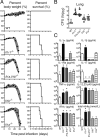Innate and adaptive interferons suppress IL-1α and IL-1β production by distinct pulmonary myeloid subsets during Mycobacterium tuberculosis infection
- PMID: 22195750
- PMCID: PMC3246221
- DOI: 10.1016/j.immuni.2011.12.002
Innate and adaptive interferons suppress IL-1α and IL-1β production by distinct pulmonary myeloid subsets during Mycobacterium tuberculosis infection
Abstract
Interleukin-1 (IL-1) receptor signaling is necessary for control of Mycobacterium tuberculosis (Mtb) infection, yet the role of its two ligands, IL-1α and IL-1β, and their regulation in vivo are poorly understood. Here, we showed that both IL-1α and IL-1β are critically required for host resistance and identified two multifunctional inflammatory monocyte-macrophage and DC populations that coexpressed both IL-1 species at the single-cell level in lungs of Mtb-infected mice. Moreover, we demonstrated that interferons (IFNs) played important roles in regulating IL-1 production by these cells in vivo. Type I interferons inhibited IL-1 production by both subsets whereas CD4(+) T cell-derived IFN-γ selectively suppressed monocyte-macrophages. These data provide a cellular basis for both the anti-inflammatory effects of IFNs and probacterial functions of type I IFNs during Mtb infection and reveal differential regulation of IL-1 production by distinct cell populations as an additional layer of complexity in the activity of IL-1 in vivo.
Copyright © 2011 Elsevier Inc. All rights reserved.
Figures







References
-
- Antonelli LR, Gigliotti Rothfuchs A, Goncalves R, Roffe E, Cheever AW, Bafica A, Salazar AM, Feng CG, Sher A. Intranasal Poly-IC treatment exacerbates tuberculosis in mice through the pulmonary recruitment of a pathogen-permissive monocyte/macrophage population. J Clin Invest. 2010;120:1674–1682. - PMC - PubMed
-
- Biswas SK, Mantovani A. Macrophage plasticity and interaction with lymphocyte subsets: cancer as a paradigm. Nat Immunol. 2010;11:889–896. - PubMed
-
- Chang EY, Guo B, Doyle SE, Cheng G. Cutting edge: involvement of the type I IFN production and signaling pathway in lipopolysaccharide-induced IL-10 production. J Immunol. 2007;178:6705–6709. - PubMed
Publication types
MeSH terms
Substances
Grants and funding
LinkOut - more resources
Full Text Sources
Other Literature Sources
Molecular Biology Databases
Research Materials

